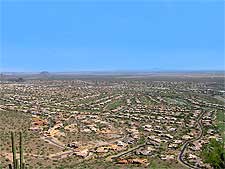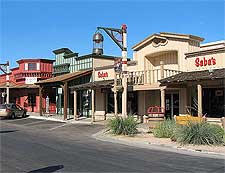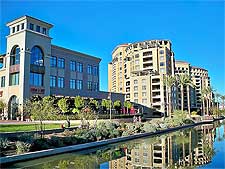Scottsdale History Facts and Timeline
(Scottsdale, Arizona - AZ, USA)

The Scottsdale area was originally settled by members of the ancient Hohokam culture in around 800 AD and later by the Pima tribe (American Indians), with remnants of the community's early beginnings still seen in the form of the many kilometers of Hohokam irrigation canals. As late as the 1960s, several Pima families continued to live in traditional dwellings on the outskirts of the town.
Scottsdale's modern history began in 1868 with the arrival of Jack Swilling, whose Irrigation Canal Company began a refurbishment of the ancient waterways.
The Pioneer Period
White settlers didn't move to this area of the American Southwest until 20 years later, following the arrival and land purchases of Winfield Scott, a US Army chaplain ordered to the region to promote the nearby settlement of
Phoenix, Arizona. Winfield's brother became the tiny town's first resident and changed its name from Orangeville to Scottsdale in 1894, by which time the settlement was well-known for its citrus, almond and fig trees, as well as its production of potatoes and peanuts, made possible thanks to the extensive irrigation of its desert soil.

Frank Lloyd Wright
The town received a welcomed boost in 1937 when internationally famous architect Frank Lloyd Wright set up camp in the foothills of the nearby McDowell Mountains, founding Taliesin West and strongly influencing the architecture of Scottsdale and its region. Many examples of Lloyd Wright's designs can be seen in town and across the area. By 1951, Scottsdale discarded its 'town' designation and became incorporated as a city.
Scottsdale Greenbelt
Between the 1950s and 1970s, the impressive Scottsdale Greenbelt came into being. It was originally created as an innovative flood prevention measure in the district of Indian Bend Wash, the site of a dry riverbed that caused occasional severe floods during rare periods of heavy rain.
By the mid-20th century, these '99-year floods' were impacting suburbanites in the district and occurring several times each decade, with the suggestion that the Army Engineers Corps should cement the riverbed into a large canal being badly received. Controversially, the city fathers voted for a series of parks and golf courses to channel the water, a move which proved highly successful in its history.

20th-Century Redevelopment
The city funds spent on the popular Greenbelt left little for the maintenance of downtown Scottsdale, which quickly fell into disrepair. The solution was provided by the timely death of a prominent ranch-owning resident, Anne McCormick, whose extensive lands were sold to developers planning a new quarter within the city limits. Once completed and including three resorts and a golf course, the upscale community soon sold to nouveau riche incomers, thus providing the tax income for the redevelopment of the downtown district, as well as the construction of the Scottsdale Center for the Arts.
Now home to over 200,000 residents, present-day Scottsdale is ranked as a premier world resort and golf destination, and has a high cost of living index as a result. Its location in the Salt River Valley - overlooked by the mountains, and its favorable local climate combine with its closeness to Phoenix to attract recreational visitors year-round. Although, for many, the summer months, with their peak temperatures of 35°C / 95°F and higher, are a little too hot.
 The Scottsdale area was originally settled by members of the ancient Hohokam culture in around 800 AD and later by the Pima tribe (American Indians), with remnants of the community's early beginnings still seen in the form of the many kilometers of Hohokam irrigation canals. As late as the 1960s, several Pima families continued to live in traditional dwellings on the outskirts of the town.
The Scottsdale area was originally settled by members of the ancient Hohokam culture in around 800 AD and later by the Pima tribe (American Indians), with remnants of the community's early beginnings still seen in the form of the many kilometers of Hohokam irrigation canals. As late as the 1960s, several Pima families continued to live in traditional dwellings on the outskirts of the town.
